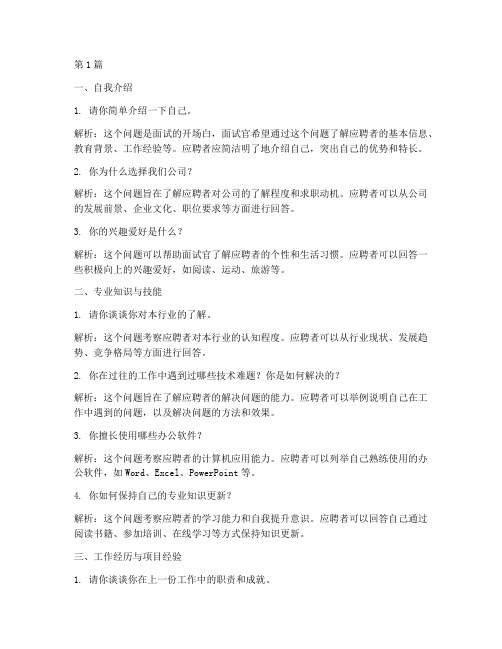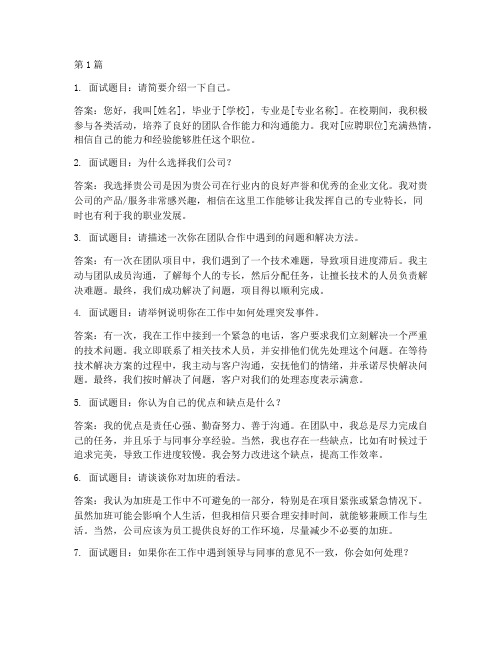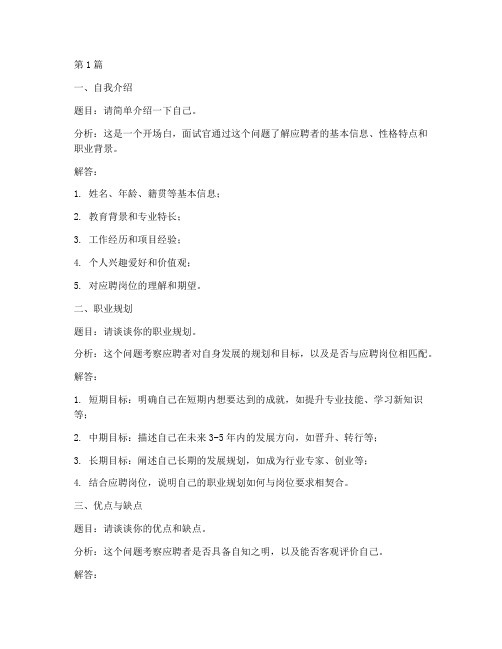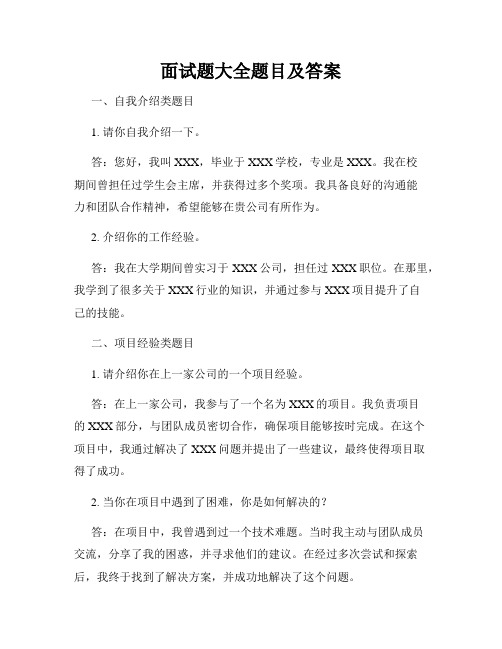1-历次面试题汇总
职场面试题目问题(3篇)

第1篇一、自我介绍1. 请你简单介绍一下自己。
解析:这个问题是面试的开场白,面试官希望通过这个问题了解应聘者的基本信息、教育背景、工作经验等。
应聘者应简洁明了地介绍自己,突出自己的优势和特长。
2. 你为什么选择我们公司?解析:这个问题旨在了解应聘者对公司的了解程度和求职动机。
应聘者可以从公司的发展前景、企业文化、职位要求等方面进行回答。
3. 你的兴趣爱好是什么?解析:这个问题可以帮助面试官了解应聘者的个性和生活习惯。
应聘者可以回答一些积极向上的兴趣爱好,如阅读、运动、旅游等。
二、专业知识与技能1. 请你谈谈你对本行业的了解。
解析:这个问题考察应聘者对本行业的认知程度。
应聘者可以从行业现状、发展趋势、竞争格局等方面进行回答。
2. 你在过往的工作中遇到过哪些技术难题?你是如何解决的?解析:这个问题旨在了解应聘者的解决问题的能力。
应聘者可以举例说明自己在工作中遇到的问题,以及解决问题的方法和效果。
3. 你擅长使用哪些办公软件?解析:这个问题考察应聘者的计算机应用能力。
应聘者可以列举自己熟练使用的办公软件,如Word、Excel、PowerPoint等。
4. 你如何保持自己的专业知识更新?解析:这个问题考察应聘者的学习能力和自我提升意识。
应聘者可以回答自己通过阅读书籍、参加培训、在线学习等方式保持知识更新。
三、工作经历与项目经验1. 请你谈谈你在上一份工作中的职责和成就。
解析:这个问题旨在了解应聘者的工作经历和业绩。
应聘者可以从工作内容、项目成果、团队协作等方面进行回答。
2. 你在过往的工作中,如何处理与同事之间的矛盾?解析:这个问题考察应聘者的沟通能力和团队协作能力。
应聘者可以举例说明自己在工作中如何与同事沟通、化解矛盾。
3. 请你谈谈你在项目中的角色和贡献。
解析:这个问题旨在了解应聘者的项目经验和团队协作能力。
应聘者可以描述自己在项目中的职责、参与程度以及取得的成果。
4. 你在上一份工作中,遇到过哪些困难?你是如何克服的?解析:这个问题考察应聘者的逆境应对能力。
20道面试题目和答案(3篇)

第1篇1. 面试题目:请简要介绍一下自己。
答案:您好,我叫[姓名],毕业于[学校],专业是[专业名称]。
在校期间,我积极参与各类活动,培养了良好的团队合作能力和沟通能力。
我对[应聘职位]充满热情,相信自己的能力和经验能够胜任这个职位。
2. 面试题目:为什么选择我们公司?答案:我选择贵公司是因为贵公司在行业内的良好声誉和优秀的企业文化。
我对贵公司的产品/服务非常感兴趣,相信在这里工作能够让我发挥自己的专业特长,同时也有利于我的职业发展。
3. 面试题目:请描述一次你在团队合作中遇到的问题和解决方法。
答案:有一次在团队项目中,我们遇到了一个技术难题,导致项目进度滞后。
我主动与团队成员沟通,了解每个人的专长,然后分配任务,让擅长技术的人员负责解决难题。
最终,我们成功解决了问题,项目得以顺利完成。
4. 面试题目:请举例说明你在工作中如何处理突发事件。
答案:有一次,我在工作中接到一个紧急的电话,客户要求我们立刻解决一个严重的技术问题。
我立即联系了相关技术人员,并安排他们优先处理这个问题。
在等待技术解决方案的过程中,我主动与客户沟通,安抚他们的情绪,并承诺尽快解决问题。
最终,我们按时解决了问题,客户对我们的处理态度表示满意。
5. 面试题目:你认为自己的优点和缺点是什么?答案:我的优点是责任心强、勤奋努力、善于沟通。
在团队中,我总是尽力完成自己的任务,并且乐于与同事分享经验。
当然,我也存在一些缺点,比如有时候过于追求完美,导致工作进度较慢。
我会努力改进这个缺点,提高工作效率。
6. 面试题目:请谈谈你对加班的看法。
答案:我认为加班是工作中不可避免的一部分,特别是在项目紧张或紧急情况下。
虽然加班可能会影响个人生活,但我相信只要合理安排时间,就能够兼顾工作与生活。
当然,公司应该为员工提供良好的工作环境,尽量减少不必要的加班。
7. 面试题目:如果你在工作中遇到领导与同事的意见不一致,你会如何处理?答案:在这种情况下,我会先了解各自的观点和理由,然后尝试找到共同点。
47个常用面试题目(3篇)

第1篇1. 请介绍一下你自己。
解析:这是面试的第一个问题,也是求职者展示自己的机会。
回答时要简洁明了,突出自己的优势和特长。
回答思路:简要介绍个人基本信息,如姓名、年龄、毕业院校等,然后重点介绍自己的职业经历、专业技能和兴趣爱好。
2. 你为什么选择这个职位?解析:面试官想了解求职者对这个职位的认识和兴趣。
回答思路:结合自己的专业背景和兴趣爱好,说明为什么对这个职位感兴趣,以及自己能为公司带来的价值。
3. 你的优势是什么?解析:面试官想了解求职者的核心竞争力。
回答思路:从专业技能、工作经验、性格特点等方面列举自己的优势,并举例说明。
4. 你的劣势是什么?解析:面试官想了解求职者的自我认知和改进能力。
回答思路:诚实地承认自己的不足,并说明如何克服这些劣势,提升自己。
5. 你对薪资有什么期望?解析:面试官想了解求职者的薪资期望是否合理。
回答思路:根据自己的工作经验和行业水平,提出一个合理的薪资期望,并说明自己的价值。
6. 你有什么问题想问我们?解析:这是求职者了解公司和职位的机会。
回答思路:可以询问公司的发展前景、团队文化、工作内容、晋升机制等问题。
7. 你能接受加班吗?解析:面试官想了解求职者的工作态度。
回答思路:表示自己愿意在必要时加班,但也要注意不要显得过于劳累。
8. 你在团队合作中遇到过什么困难?解析:面试官想了解求职者的沟通能力和解决问题的能力。
回答思路:举例说明在团队合作中遇到的困难,以及自己如何克服这些问题。
9. 你如何处理工作中的压力?解析:面试官想了解求职者的抗压能力。
回答思路:说明自己在面对压力时的应对策略,如调整心态、寻求支持等。
10. 你如何看待工作中的失误?解析:面试官想了解求职者的责任心和改进能力。
回答思路:表示自己会认真对待工作中的失误,分析原因,并采取措施改进。
11. 你如何提升自己的专业技能?解析:面试官想了解求职者的学习能力和自我提升意识。
回答思路:说明自己如何通过学习、实践和交流来提升专业技能。
面试题目和问题(3篇)

第1篇一、面试题目1. 请用3分钟时间,简单介绍一下你自己。
2. 请谈谈你对市场营销岗位的理解,为什么选择这个岗位?3. 请描述一个你认为成功的市场营销案例,并分析其成功的原因。
4. 请谈谈你对当前市场营销趋势的看法,以及你认为未来市场营销的发展方向。
5. 请结合实际案例,说明如何运用互联网思维进行市场营销。
6. 请谈谈你对品牌建设的理解,以及如何提升品牌知名度。
7. 请描述一次你在市场营销活动中遇到的问题,以及你是如何解决的。
8. 请谈谈你对竞争对手的分析,以及如何制定有效的竞争策略。
9. 请谈谈你对市场调研的理解,以及如何运用市场调研数据指导市场营销决策。
10. 请谈谈你对团队合作的理解,以及如何与团队成员高效沟通和协作。
二、面试问题1. 请用3分钟时间,简单介绍一下你自己。
问题:(1)你的姓名、年龄、籍贯等信息。
(2)你的教育背景、专业特长和兴趣爱好。
(3)你的职业规划和发展目标。
2. 请谈谈你对市场营销岗位的理解,为什么选择这个岗位?问题:(1)你对市场营销的理解是什么?(2)你认为市场营销在企业中的作用是什么?(3)为什么你对这个岗位感兴趣?3. 请描述一个你认为成功的市场营销案例,并分析其成功的原因。
问题:(1)请描述一个你认为成功的市场营销案例。
(2)分析该案例成功的原因。
(3)你认为该案例对你的市场营销工作有哪些启示?4. 请谈谈你对当前市场营销趋势的看法,以及你认为未来市场营销的发展方向。
问题:(1)你认为当前市场营销趋势有哪些?(2)你认为未来市场营销的发展方向是什么?(3)你对这些趋势有何看法?5. 请结合实际案例,说明如何运用互联网思维进行市场营销。
问题:(1)请描述一个实际案例,说明如何运用互联网思维进行市场营销。
(2)分析该案例中互联网思维的应用。
(3)你认为如何将互联网思维融入到你的市场营销工作中?6. 请谈谈你对品牌建设的理解,以及如何提升品牌知名度。
问题:(1)你对品牌建设的理解是什么?(2)你认为如何提升品牌知名度?(3)请结合实际案例,说明如何进行品牌建设。
6个面试题目盘点(3篇)

第1篇一、自我介绍题目:请简单介绍一下自己。
分析:这是一个开场白,面试官通过这个问题了解应聘者的基本信息、性格特点和职业背景。
解答:1. 姓名、年龄、籍贯等基本信息;2. 教育背景和专业特长;3. 工作经历和项目经验;4. 个人兴趣爱好和价值观;5. 对应聘岗位的理解和期望。
二、职业规划题目:请谈谈你的职业规划。
分析:这个问题考察应聘者对自身发展的规划和目标,以及是否与应聘岗位相匹配。
解答:1. 短期目标:明确自己在短期内想要达到的成就,如提升专业技能、学习新知识等;2. 中期目标:描述自己在未来3-5年内的发展方向,如晋升、转行等;3. 长期目标:阐述自己长期的发展规划,如成为行业专家、创业等;4. 结合应聘岗位,说明自己的职业规划如何与岗位要求相契合。
三、优点与缺点题目:请谈谈你的优点和缺点。
分析:这个问题考察应聘者是否具备自知之明,以及能否客观评价自己。
解答:1. 优点:列举与应聘岗位相关的优点,如责任心强、沟通能力强、团队合作精神等;2. 缺点:坦诚地承认自己的不足,如沟通能力有待提高、时间管理能力有待加强等;3. 对于缺点,可以说明自己在努力改进,并提出具体的改进措施。
四、抗压能力题目:请谈谈你在工作中遇到的困难,以及你是如何克服的。
分析:这个问题考察应聘者的抗压能力和解决问题的能力。
解答:1. 描述遇到的困难,如工作压力、团队冲突等;2. 说明自己是如何应对这些困难的,如调整心态、寻求帮助、制定解决方案等;3. 强调自己具备较强的抗压能力和解决问题的能力。
五、团队合作题目:请谈谈你在团队合作中的角色和贡献。
分析:这个问题考察应聘者的团队合作能力和沟通能力。
解答:1. 描述自己在团队中的角色,如领导者、执行者等;2. 说明自己在团队中的贡献,如提出建设性意见、协助团队成员解决问题等;3. 强调自己在团队合作中的积极性和责任感。
六、应急应变能力题目:请谈谈你在工作中遇到突发事件时,是如何处理的。
面试题大全题目及答案

面试题大全题目及答案一、自我介绍类题目1. 请你自我介绍一下。
答:您好,我叫XXX,毕业于XXX学校,专业是XXX。
我在校期间曾担任过学生会主席,并获得过多个奖项。
我具备良好的沟通能力和团队合作精神,希望能够在贵公司有所作为。
2. 介绍你的工作经验。
答:我在大学期间曾实习于XXX公司,担任过XXX职位。
在那里,我学到了很多关于XXX行业的知识,并通过参与XXX项目提升了自己的技能。
二、项目经验类题目1. 请介绍你在上一家公司的一个项目经验。
答:在上一家公司,我参与了一个名为XXX的项目。
我负责项目的XXX部分,与团队成员密切合作,确保项目能够按时完成。
在这个项目中,我通过解决了XXX问题并提出了一些建议,最终使得项目取得了成功。
2. 当你在项目中遇到了困难,你是如何解决的?答:在项目中,我曾遇到过一个技术难题。
当时我主动与团队成员交流,分享了我的困惑,并寻求他们的建议。
在经过多次尝试和探索后,我终于找到了解决方案,并成功地解决了这个问题。
三、团队合作类题目1. 请举一个你曾经在团队中取得成功的例子。
答:在大学期间,我曾参与过一个团队项目。
我们团队成员各司其职,相互配合,最终成功地完成了项目。
我的职责是XXX,我根据项目的要求完成了XXX,并通过与队友协作,确保项目能够顺利推进。
2. 当你与团队成员意见不合时,你是如何解决的?答:在团队合作中,意见不合是很正常的事情。
我会尊重他人的意见,并通过积极的沟通、妥协和理解,最终找到一个大家都满意的解决方案。
四、个人能力类题目1. 你认为你的最大优点是什么?答:我认为我的最大优点是我的学习能力和适应能力。
我能够迅速地学习新知识,并能够适应新环境和新任务,这使得我能够不断自我提升并取得好的工作效果。
2. 你认为你的最大缺点是什么?答:我认为我的最大缺点是有时候过于追求完美。
我会花费较多的时间和精力来做一件事,以求达到最好的效果。
但有时候这会导致我在时间紧迫的情况下无法及时完成任务。
历年面试题目(3篇)
第1篇一、综合分析类1. 题目:请谈谈你对当前社会热点问题的看法。
解析:此类题目考察考生对社会热点的关注程度、分析问题的能力以及解决问题的思路。
考生在回答时,应结合实际,表达自己的观点,并能够提出合理的解决方案。
2. 题目:你认为团队合作和竞争的关系是什么?解析:此类题目考察考生对团队合作与竞争的理解,以及在实际工作中如何处理二者关系。
考生在回答时,应明确指出团队合作与竞争的辩证关系,并阐述如何在团队中发挥个人优势,实现团队目标。
3. 题目:请谈谈你对当前国家政策的理解。
解析:此类题目考察考生对国家政策的关注程度,以及对政策背后意图的把握。
考生在回答时,应结合自身专业背景,分析政策对行业发展、社会进步的影响,并提出自己的见解。
二、专业知识类1. 题目:请简要介绍你所学的专业知识,并谈谈如何将其应用于实际工作中。
解析:此类题目考察考生对所学专业的掌握程度,以及运用专业知识解决实际问题的能力。
考生在回答时,应突出所学专业的重要性,并结合实际案例,阐述专业知识在解决问题中的作用。
2. 题目:请谈谈你对我国(或所在行业)当前发展趋势的看法。
解析:此类题目考察考生对行业发展趋势的把握,以及预测未来发展趋势的能力。
考生在回答时,应结合自身专业背景,分析行业现状,预测未来发展趋势,并提出应对策略。
3. 题目:请谈谈你对我国(或所在行业)相关政策法规的理解。
解析:此类题目考察考生对相关政策法规的掌握程度,以及在实际工作中如何运用法规知识。
考生在回答时,应明确指出相关政策法规的意义,并结合实际案例,阐述法规在维护权益、规范行为等方面的作用。
三、情境模拟类1. 题目:假设你是一名部门经理,如何处理下属之间因工作矛盾而产生的冲突?解析:此类题目考察考生在团队管理方面的能力,以及处理人际关系的技巧。
考生在回答时,应明确指出处理冲突的原则和方法,如沟通、协调、激励等,并结合实际案例,阐述如何解决下属之间的矛盾。
2. 题目:你所在的项目组遇到了一个难题,团队成员意见不统一,你作为项目负责人,如何带领团队克服困难?解析:此类题目考察考生在项目管理方面的能力,以及团队领导力。
面试最多的面试题目答案(3篇)
第1篇一、面试题目:请介绍一下你自己。
答案:尊敬的面试官,您好!我叫XXX,毕业于XXX大学,专业是XXX。
在过去的几年里,我积累了丰富的实习经验和实践经验,以下是我对自己的简要介绍:1. 个人背景我出生在一个温馨和睦的家庭,从小受到良好的家庭教育。
在学习过程中,我始终保持着对知识的渴望和追求,努力提高自己的综合素质。
在校期间,我积极参加各类社团活动,锻炼自己的组织协调能力和团队合作精神。
2. 专业技能(1)专业知识:在大学期间,我认真学习专业知识,打下了扎实的理论基础。
通过课程学习和实践项目,我对XXX领域的相关技术有了深入了解。
(2)计算机技能:熟练掌握XXX、XXX等编程语言,具备一定的数据库管理能力。
同时,我对计算机操作系统、网络技术等也有一定的了解。
(3)英语能力:具备良好的英语听说读写能力,通过CET-6考试,能够熟练阅读英文技术文档,具备一定的英语沟通能力。
3. 实习经历在大学期间,我曾参加过XXX公司、XXX企业等单位的实习。
在这些实习经历中,我不仅锻炼了自己的实际操作能力,还学会了如何与同事、领导沟通协作,提高了自己的职业素养。
4. 项目经验(1)XXX项目:在XXX项目中,我负责XXX模块的开发工作。
在项目过程中,我遇到了XXX问题,通过查阅资料、请教同事,最终成功解决了问题。
(2)XXX项目:在XXX项目中,我担任XXX角色,与团队成员共同完成了项目目标。
在此过程中,我学会了如何合理分配任务、协调团队资源,提高了自己的项目管理能力。
5. 个人品质(1)责任心强:我对待工作认真负责,能够按时完成各项任务。
(2)学习能力强:具备较强的自学能力和适应能力,能够迅速掌握新知识、新技术。
(3)团队合作精神:具有良好的团队合作精神,能够与同事相互支持、共同进步。
(4)沟通能力:具备良好的沟通能力,能够与不同背景的人进行有效沟通。
总之,我相信自己的综合素质和能力能够胜任贵公司的职位。
如果有机会加入贵公司,我将全力以赴,为公司的发展贡献自己的力量。
高频面试题及答案
高频面试题及答案1. 请简单介绍一下你自己。
- 参考答案:您好,我叫[姓名],毕业于[学校],专业是[专业]。
在校期间,我积极参与各类实践活动,锻炼了我的[某项技能]。
我对[行业/职位]充满热情,并且有[相关经验]。
我相信我的背景和技能可以为贵公司带来价值。
2. 你为什么想加入我们公司?- 参考答案:我选择贵公司是因为[公司名称]在[行业]领域有着卓越的声誉和领导地位。
我对公司的[某项产品/服务]特别感兴趣,并且我认为我的[技能/经验]能够为公司的发展做出贡献。
3. 你如何看待团队合作?- 参考答案:我认为团队合作是实现目标的关键。
在团队中,每个成员都应该发挥自己的长处,同时尊重和支持其他成员。
有效的沟通和协作是团队成功的关键。
4. 你如何处理工作中的压力?- 参考答案:面对工作压力,我会首先确定问题的根源,然后制定一个清晰的解决方案。
我通常会优先处理最重要的任务,并且合理分配时间。
此外,保持积极的心态和适当的休息也是缓解压力的有效方法。
5. 你认为自己最大的优点和缺点是什么?- 参考答案:我最大的优点是[优点],这使我在[某方面]表现出色。
至于缺点,我认为是[缺点],但我正在通过[改进方法]来克服它。
6. 你如何看待失败?- 参考答案:我认为失败是成功的一部分,它提供了学习和成长的机会。
当面对失败时,我会分析原因,从中吸取教训,并调整策略以避免重复同样的错误。
7. 你有什么职业规划?- 参考答案:我的短期目标是在[行业/职位]领域内积累经验,提升自己的专业技能。
长期来看,我希望能够成为[行业/职位]的专家,并为公司的发展做出更大的贡献。
8. 如果你被录用,你将如何快速融入团队?- 参考答案:如果我有幸被录用,我会通过积极参与团队活动和项目来快速融入团队。
同时,我会主动与团队成员沟通,了解他们的工作方式和需求,以便更好地协作。
9. 你如何看待加班?- 参考答案:我认为加班是工作的一部分,特别是在项目紧张或截止日期临近时。
往届面试题目大全(3篇)
第1篇一、综合理解与表达类1. 请简要介绍一下自己。
2. 你认为自己的优势和劣势是什么?3. 你如何看待团队合作?4. 你如何看待竞争与合作的关系?5. 请谈谈你的人生观、价值观。
6. 你认为自己的职业规划是什么?7. 请谈谈你最近读过的一本书,以及给你的启发。
8. 你如何看待加班文化?9. 请谈谈你对未来社会的看法。
10. 你认为成功的关键因素是什么?二、专业知识与技能类1. 请简要介绍一下你所学的专业。
2. 你认为你的专业在实际工作中有哪些应用?3. 请谈谈你对本行业发展趋势的看法。
4. 你熟悉哪些软件或工具,它们在你学习或工作中起到了什么作用?5. 请谈谈你对本行业常见问题的解决方法。
6. 你熟悉哪些编程语言或工具,请举例说明你在实际工作中如何应用它们。
7. 请谈谈你对项目管理或团队协作的理解。
8. 你熟悉哪些数据库,请举例说明你在实际工作中如何应用它们。
9. 请谈谈你对市场营销或广告推广的理解。
10. 你熟悉哪些财务分析或投资策略,请举例说明你在实际工作中如何应用它们。
三、情景模拟与问题解决类1. 假设你是一名项目经理,现在团队面临项目延期的问题,你该如何解决?2. 你所在的部门要招聘一名新员工,你会如何挑选合适的候选人?3. 你在工作中遇到了一个难以解决的问题,你该如何处理?4. 假设你是一名销售员,客户对你的产品提出了质疑,你该如何应对?5. 你所在的公司要推出一款新产品,你会如何进行市场调研?6. 假设你是一名人力资源经理,现在公司面临员工流失的问题,你该如何解决?7. 你在工作中遇到了一个突发事件,需要立即处理,你会如何应对?8. 假设你是一名研发人员,现在需要解决一个技术难题,你会如何着手?9. 你在工作中遇到了一个道德困境,你会如何抉择?10. 假设你是一名领导,如何激励团队成员完成目标?四、行为面试与案例分析类1. 描述一次你在团队合作中遇到困难并成功解决的经历。
2. 描述一次你在面对压力时保持冷静并解决问题的经历。
- 1、下载文档前请自行甄别文档内容的完整性,平台不提供额外的编辑、内容补充、找答案等附加服务。
- 2、"仅部分预览"的文档,不可在线预览部分如存在完整性等问题,可反馈申请退款(可完整预览的文档不适用该条件!)。
- 3、如文档侵犯您的权益,请联系客服反馈,我们会尽快为您处理(人工客服工作时间:9:00-18:30)。
基础题1、static能否与const或virtual共同修饰函数static不能与const一起修饰函数,C++编译器在实现const的成员函数的时候为了确保该函数不能修改类的实例的状态,会在函数中添加一个隐式的参数const this*。
但当一个成员为static的时候,该函数是没有this指针的。
也就是说此时const的用法和static是冲突的。
static也不能与virtual一起修饰函数,Virtual functions are invoked when you have a pointer/reference to an instance of a class. Static functions aren't tied to a particular instance, they're tied to a class. C++ doesn't have pointers-to-class, so there is no scenario in which you could invoke a static function virtually.注意:用const修饰函数,是说该函数不能改变成员的值,因此者这个函数的this指针是const的,但是如果我用static修饰的话,这个时候这个函数是没有this指针的,因此两个不能同时修饰函数。
2、桶排序大致思路是将数据进行划分,在各自划分的桶中做排序,然后再按照桶号从小到大输出。
#include<iostream>#include<vector>#include<algorithm>usingnamespace std;void bucket_sort(vector<int>&num){int mini = INT_MAX, maxi = INT_MIN;for(int i=0; i<num.size(); i++){if(num[i] < mini)mini = num[i];if(num[i] > maxi)maxi = num[i];}int nBasket = 5;int space = (maxi-mini+1)/nBasket;vector<int> *basket = new vector<int>[nBasket];for(int i=0; i<num.size(); i++){int k = (num[i]-mini)/space;basket[k].push_back(num[i]);}int pos = 0;for(int i=0; i<nBasket; i++){sort(basket[i].begin(), basket[i].end());for(int j=0; j<basket[i].size(); j++)num[pos++] = basket[i][j];}delete[] basket;}int main(){vector<int> num;for(int i=0; i<100; i++)num.push_back(100-i);bucket_sort(num);for(int i=0; i<num.size(); i++)cout << num[i] <<" ";}3、内存只有1G,是否可以new 4G内存空间Memory pages aren't actually mapped to your program until you use them. All malloc does is reserve a range of the virtual address space. No physical RAM is mapped to those virtual pages until you try to read or write them.Even when you allocate global or stack ("automatic") memory, there's no mapping of physical pages until you touch them.Finally, sizeof() is evaluated at compile time, when the compiler has no idea what the OS will do later. So it will just tell you the expected size of the object.You'll find that things will behave very differently if you try to memset the memory to 0 in each of your cases. Also, you might want to try calloc, which zeroes its memory.32位意味着4G的寻址空间,linux把它分为两部分:最高的1G(虚拟地址从0xC0000000到0xffffffff)用做内核本身,成为“系统空间”,而较低的3G字节(从0x00000000到0xbffffff)用作各进程的“用户空间”。
这样,理论上每个进程可以使用的用户空间都是3G。
当然,实际的空间大小收到物理存储器大小的限制。
虽然各个进程拥有其自己的3G用户空间,系统空间却由所有的进程共享。
从具体进程的角度看,则每个进程都拥有4G的虚拟空间,较低的3G为自己的用户空间,最高的1G 为所有进程以及内核共享的系统空间。
可是经自己测试:堆区最多开2G - 1大小空间栈区能开1G多,当接近2G就会报错栈空间地址会从高地址向低地址分配,而堆空间地址会从低地址向高地址分配。
问题1:用户态总共可访问的空间是3G,所以申请3G空间肯定越界了。
注意:Linux在申请空间时并不是一次给予要求的所有空间,在需要时通过缺页异常按页进行分配。
此外malloc申请空间在heap 中,具体能申请的最大值还要看stack已占据的大小,heap中已经被分配的大小等因素决定,但2G 明显小于3G,在上述条件满足时可申请。
算法题1、找出两个字符串的最大公共子串思路1:复杂度为O(n*m),空间复杂度为为O(m)dp[i][j] = s1[i]==s2[j]? dp[i-1][j-1]+1: 0.dp[i][j]表示字符串s1以i结尾,字符串s2以j结尾的共同子串的长度,然后我们还辅助变量length 和index来分别记录最长公共子串的长度和结束位置。
此外,由于dp[i][j]只与上一行相关,所以我们可以使用一维数组,无需使用2维数组就可搞定。
string commonString(string s1, string s2){int len1 = s1.size(), len2 = s2.size();vector<int> dp(len2, 0);int index = -1, length = 0;for(int i=0; i<len1; i++){for(int j=len2-1; j>=0; j--) //记住,这里j要从后往前。
如果从前往后就会污染之前的记录结果。
{if(s1[i] == s2[j]){int n = 1+(j>0? dp[j-1]: 0);dp[j] = n;if(dp[j] > length){length = dp[j];index = i;}}elsedp[j] = 0;}}return s1.substr(index-length+1, length);}2、给定一个数组,求出连续序列和的绝对值最小的序列这道题是求连续序列和的最大值的变种解这道题首先需要开辟数据sum,其中sum[i] 为从num[0]加到num[i]的结果。
然后对sum进行排序,然后求出min{abs(sum[i]), abs(sum[i]-sum[i+1])},这个思路很巧妙,多思考代码如下:int calMinAbs(vector<int>&num){if(num.empty()) return 0;vector<int> sum(num.size(), 0);int record = 0;for(int i=0; i<num.size(); i++){record += num[i];sum[i] = record;}sort(sum.begin(), sum.end());int ans = INT_MAX;for(int i=0; i<sum.size(); i++){if(abs(sum[i]) < ans)ans = abs(sum[i]);if(i>0 && sum[i]-sum[i-1] < ans)ans = sum[i]-sum[i-1];}return ans;}3、k路归并排序void Adjust(int *ls, int *index, vector<vector<int>>&data, int k, int s){int t = (s+k)/2;while(t>0){if(data[s][index[s]] > data[ls[t]][index[ls[t]]]){int temp = s;s = ls[t];ls[t] = temp;}t = t/2;}ls[0] = s;}void CreateLoserTree(int *ls, int *index, vector<vector<int>>&data, int k) {for(int i=0; i<k; i++)ls[i] = k;for(int i=k-1; i>=0; i--)Adjust(ls, index, data, k, i);}void kMerge(vector<vector<int>>&data){if(data.empty()) return ;int k = data.size();int *index = newint[k+1];int *ls = newint[k];data.push_back(vector<int>());for(int i=0; i<k; i++){index[i] = 0;data[i].push_back(INT_MAX);}index[k] = 0;data[k].push_back(INT_MIN);CreateLoserTree(ls, index, data, k);while(data[ls[0]][index[ls[0]]] != INT_MAX){cout << data[ls[0]][index[ls[0]]] <<" ";index[ls[0]]++;Adjust(ls, index, data, k, ls[0]);}delete[] index;delete[] ls;data.pop_back();for(int i=0; i<k; i++)data[i].pop_back();}4、将两个字符串里的单词进行合并,单词从小到大排序,单词之间只有一个空格网易游戏笔试题5、设计实现pow(x, n)的快速计算方法首先判断各种corner case,比如x=0时,pow(0, n)=1; x!=0,n=0时,pow(x, 0)=1。
